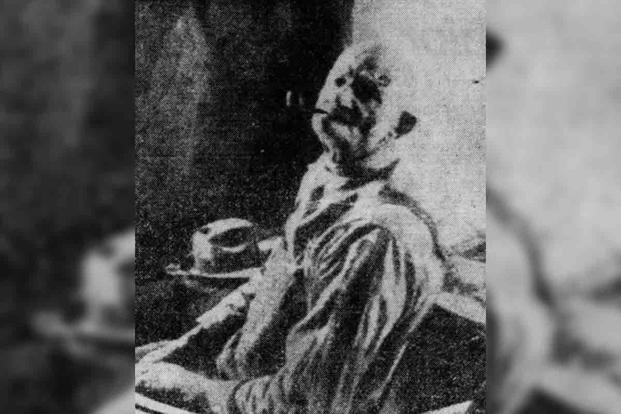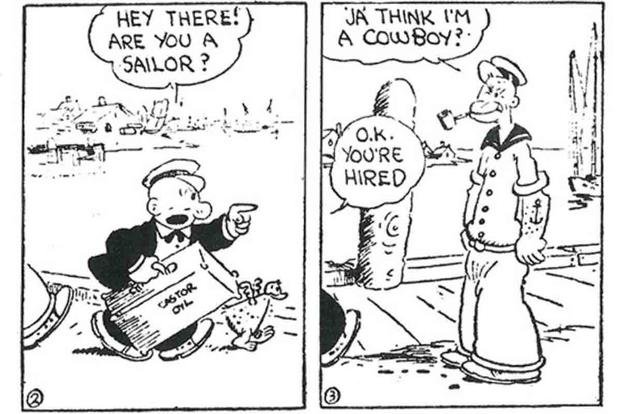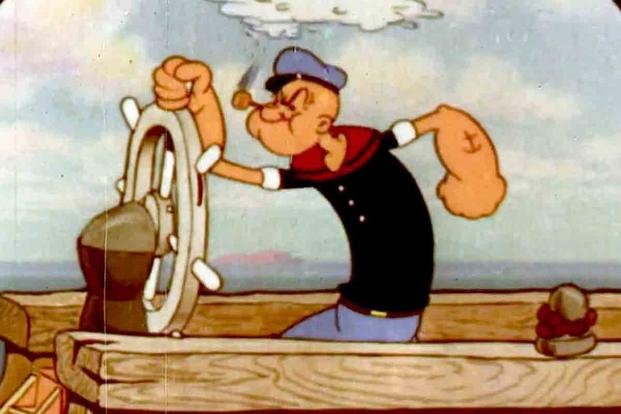When most people think of Popeye, we probably think about a hard-hitting sailor man fueled by a love for canned spinach. But the real inspiration for the rowdy animated mariner came from someone who was known to be a fighter and was most likely to throw hands after a few drinks -- but certainly not over olive oil.
Frank "Rocky" Fiegel was a longtime resident of Chester, Illinois, and was certainly not a sailor. But at 5'11" and 175 pounds, many locals believed Rocky could have been a champion boxer if he had gone that route rather than just fighting in bars and saloons. Instead of that, in the early 1920s, those brawls earned him a notoriety that would extend far past the county line and well beyond his death in 1947.

He worked as a general laborer when he wasn't in the barroom, and he was known to show off feats of strength and toughness, even during long days of hard work. For all his strength and intoxicated bravado, however, Rocky loved kids and was known for handing out candy and sweets to the town's children. The cartoonist and creator of "Popeye," E.C. Segar, was one of those children.
When Segar created his soon-to-be legendary comic character in 1929, he not only used Fiegel's strength and penchant for confrontation, but the man's appearance as well. Just like the fictional spinach-loving mariner, Fiegel was a one-eyed, pipe-smoking curmudgeon with a jutting chin.
Segar needed a sailor for his long-running daily comic, "Thimble Theatre," for the Jan. 17, 1929, strip. Popeye was recruited from the local docks to take the main character, Castor Oyl, to an island. Segar modeled Popeye after Fiegel, probably thinking he'd quickly forget about the sailor man forever.
But readers didn't forget. Newspapers began requesting Popeye's return, and just a few months later, Segar obliged. Readers loved Popeye the sailor so much that it wasn't long before he became the central character of the entire comic strip. How many of you reading this right now even remember that Castor Oyl existed?

Popeye's popularity exploded throughout the 1930s, but back in Chester, Illinois, Rocky Fiegel continued to work odd jobs and fight in bars. He had no idea he was the inspiration (visually, at least) for one of America's most popular comic characters, featured in 500 newspapers across the nation and animated cartoons.
Segar died of leukemia in 1938, at the age of 43. Back in his hometown, Fiegel was 69 and as wiry and rambunctious as ever. It was only then that Fiegel learned how close he really was to his hometown's famed sailor man. To mark the "Popeye" creator's passing, the St. Louis Post-Dispatch, the closest major newspaper to Chester, printed a photo of Fiegel, sitting in a rocking chair with a pipe in his mouth, noting that he was the inspiration for Segar's iconic character.
No one is really sure what effect it had on the man. Some of the locals aren't sure Fiegel ever knew he was Popeye. The old man lived with his mother for the rest of her life, then lived in the same house for the rest of his own life. He died in 1947 and was buried in an unmarked grave. It remained unmarked until the Official Popeye Fan Club erected a headstone for him that featured a 1929 rendition of Popeye the Sailor.
Keep Up With the Best in Military Entertainment
Whether you're looking for news and entertainment, thinking of joining the military or keeping up with military life and benefits, Military.com has you covered. Subscribe to the Military.com newsletter to have military news, updates and resources delivered straight to your inbox.
















